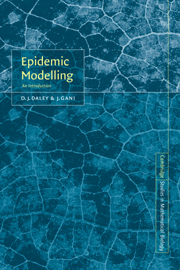5 - Rumours: Modelling Spread and its Cessation
Published online by Cambridge University Press: 16 November 2009
Summary
This chapter is devoted to further models of spread in a population, most of them appealing to the Law of Mass Action. Our aim is to exemplify the modelling principles found useful in other problems involving the spread of an attribute through a population. It is important to note that except for models in which the only ‘mechanism’ is that of spreading, as for example in the case of a simple epidemic, the range of behaviour exhibited by processes with a removal mechanism is quite varied.
The two key features of previous models involve the spread of a disease and the removal of infectious individuals. We have given some emphasis in Chapters 2, 3 and 4 to the spread of disease by other than homogeneous mechanisms. In this chapter we look also at a variety of removal mechanisms, such as may apply to the spread of a rumour (an ‘infection of the mind’). We show that different removal mechanisms can lead to somewhat different conclusions from those of earlier chapters, where threshold phenomena were of particular interest.
Rumour models
The earliest references in the probability literature to a rumour model appear in the work of Rapoport and co-workers from 1948 onwards (see Bartholomew (1967) for references), in Feller (1957, Exercises 11.10.21–22) though not in his first (1950) edition, and in Kendall (1957). Here we take as our basic model that described in Daley and Kendall (1965) (called [DK] below), where the original motivation for its formulation was the possible similarity in the spread of physiological and psychological infections (cf. Daley and Kendall, 1964).
- Type
- Chapter
- Information
- Epidemic ModellingAn Introduction, pp. 133 - 153Publisher: Cambridge University PressPrint publication year: 1999
- 1
- Cited by



